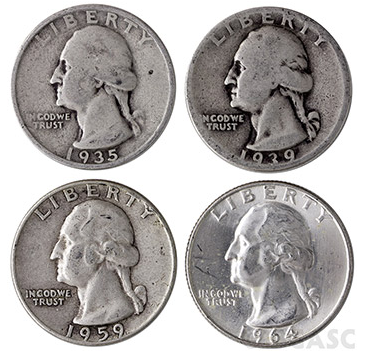
Presidents On United States Coins
U.S. Coins Once Featured Images of Liberty, Indian Heads and Eagles, Not Presidents on Their Obverses
The Lincoln Penny
The United States, has been minting coins since 1792. Yet, no American President appeared on a U.S. coin until 1909. To commemorate the one hundreth year of President Lincoln’s birth, in 1909 the U.S. Mint began producing one cent coins with the 16th U.S. President image on the front. The Lincoln Penny replaced the Indian Head Penny that had been minted since 1859.
While it seems commonplace today that Presidents grace the front of U.S. coins, the introduction of the Lincoln Penny broke a 117 year streak of NOT having President featured on coins. The Coinage Act of April 2, 1792, signed by President George Washington, required U.S. coins to have “…an impression emblematic of liberty.”
Since the introduction of the Lincoln Penny, here are the other U.S. coins that have featured United States Presidents:
The Washington Quarter (1932 – present)
The first U.S. President, George Washington, made his first appearance on a U.S. coin intended for general circulation in 1932. (although his visage was featued on the 1900 Lafayette commemorative dollar, with the Marquis de Lafayette) Mr. Washington’s profile first appeared on the quarter dollar to commemorate the 200th year anniversary of his birth. The Washington Quarter replaced the Standing Liberty Quarter (1916-1930).
The Washington Quarter dollar was minted with 90% silver and 10% copper from 1932-1964. Since 1965 the Washington Quarter has been minted with a copper/nickel outer layer and a copper core.

The Jefferson Nickel (1938 – present)
Five years after the introduction of the Washington Quarter, the U.S. Mint began producing five cent pieces featuring the profile of the United States’ third President and primary drafter of the U.S. Declaration of Independence, Thomas Jefferson. The Jefferson Nickel replaced the Buffalo Nickel (1913-1938). The Jefferson Nickel is comprised 75% copper and 25% nickel.
The Roosevelt Dime (1946-present)
In 1946, a year after the death of Franklin Delano Roosevelt, the United States 32nd President, the U.S. Mint introduced ten cent pieces (dimes) that showed the profile of Franklin Roosevelt. The Roosevelt Dime replaced the Winged Liberty Head or Mercury Dime that was in production from 1916-1945. The Roosevelt Dime was minted in 90% silver and 10% copper from 1946-1964. Since 1965, the Roosevelt Dime has been minted with a copper/nickel outer layer and a copper core.

The Kennedy Half Dollar (1964- present)
In 1964, just months after the assassination of John F. Kennedy on November 22, 1963, the U.S. Mint introduced the Kennedy Half Dollar ($.50) featuring the profile of the United States’ 35th President. The Kennedy Half Dollar replaced the Franklin Half Dollar (1948-1963). The Kennedy Half Dollar was minted of 90% silver and 10% copper in 1964 only. From 1965-1970, the Kennedy Half Dollar contained 40% silver and 60% copper.
Since 1971, Kennedy Half Dollars have been minted with a copper/nickel outer layer and a copper core. Since 2002 the Kennedy Half Dollar has been minted in collector form only, not intended for general circulation.

The Eisenhower Dollar (1971-1978)
In 1971, Dwight D Eisenhower, 34th President of the United States and Supreme Commander of the Allied Forces of the D-Day invasion of Northern France on June 6, 1944, became the first U.S. President to be featured on a dolllar coin. The Eisenhower Dollar was minted between 1971 and 1978.
Presidential Dollars (2007-2016)
In 2007, the U.S. Mint introduced a series of Presidential dollar coins. Over the course of the mintage of the series each of the United States presidents are featured in chronological order, starting with the issuance of coins featuring the first four U.S. Presidents (Washington, Adams, Jefferson and Madison). The Presidential Dollars were issued for general circulation from 2007-2011. Since 2012, Presidential Dollars have been issued for collectors only.
Did you know? The Federal Holiday President’s Day is designated to fall each year on the Monday between February 12 (Lincoln’s birthday) and February 22 (Washington’s birthday).
All Blog Articles are provided by a third party and do not necessarily reflect the explicit views of BGASC, nor should they be construed as financial advice.
